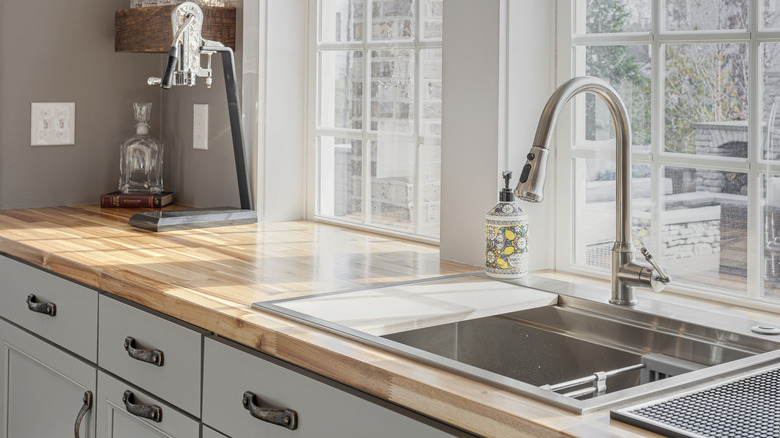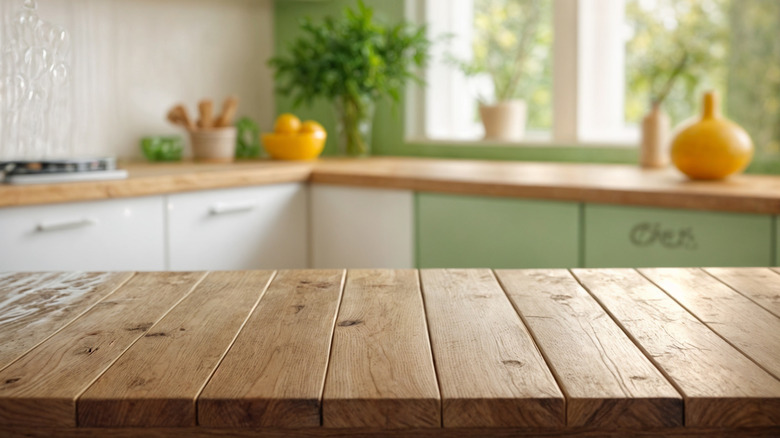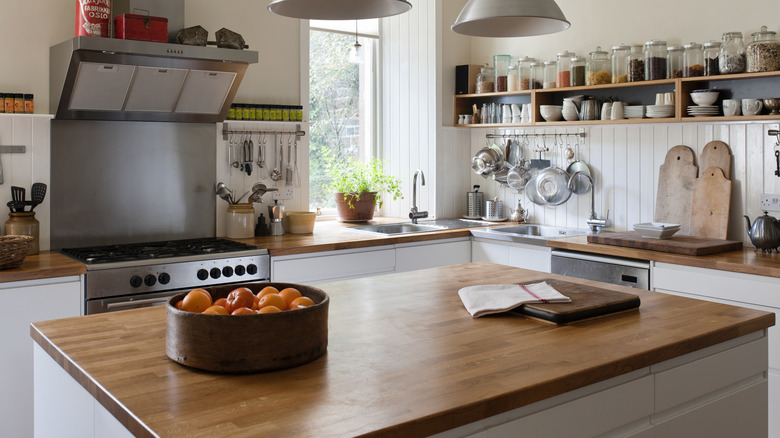DIY Your Own Faux Reclaimed Wood For A Fraction Of The Price
Using reclaimed wood in home projects can be an eco-friendly way to upcycle old wood into character-adding decor for your space. Wooden countertops have exploded in popularity, and using reclaimed wood can take your farmhouse chic kitchen to a whole other level. The problem with using reclaimed wood is it can be a very involved and expensive process to prepare the boards for that rustic barnyard countertop look. Reclaimed wood usually requires significant planing to become usable, so you lose a lot of that aged charm, which defeats the whole purpose. Paying for professionally sourced reclaimed wood, however, can also be a deal breaker.
What to do? One option is to make faux reclaimed wood using new wood planks. That way, you can have all the charm of aged and weathered wood without any of the practical drawbacks. Using household items, wood stains, and a little creativity, you can transform a new wood countertop into a rustic focal point for a fraction of the cost (and headache!) of working with reclaimed wood.
How to turn new wood into reclaimed wooden countertops
First, start with a plywood base and lay out your countertop planks. When choosing wood planks, consider going with two different widths to avoid a cookie-cutter, butcher-block look. (You can also DIY faux butcher block countertops, by the way!)
You can install your countertops first and then age them, or vice versa. There are a couple of unconventional (and frugal!) ways to give wood a weathered and aged look:
- Use a sander to create varying grooves between the board seams. Switch up the pressure as you sand so it looks to have aged naturally.
- Rough up a few parts of the countertop by hammering chicken wire to 'stamp' it sporadically.
- Use a wire brush to accentuate the grain in some areas.
- Lay a screw on its side and give it a few whacks with a hammer to etch the threads into the countertop. You can also lightly hammer the end for some character-adding nicks.
Finally, stain and seal your countertops. You can use different stains for a multi-tonal weathered look or sand back some of the stain to prevent it from looking too uniform. Mixing the stain with paint thinner will result in more buildable coats while also helping the dark pigments settle down into the grain as well as the imperfections you made to bring your faux reclaimed wood to life. Seal with a high-quality waterproof sealant such as Waterlox on Amazon.
What to know before building your own wood countertops
Wooden countertops are beautiful and practical, but there are a few things to know before you install them. Wood is more prone to damage than other countertop materials, especially if it is not sealed well. Even store-bought wooden countertops should be resealed periodically with food-grade mineral oil, so be sure to seal them properly from the start if you build them yourself as mentioned above. When it comes to cleaning, mild dish soap and water should do the trick, and you can also use salt and lemon juice to tackle stains.
The type of wood you choose also matters. Harder woods are more durable and scratch-resistant, so they are ideal for countertops. Though Poplar is considered a soft wood, it's hard enough to be considered a good, budget-friendly option that is easily accessible. Maple is the most popular option for butcher block and makes a lovely DIY option as well. Black walnut, white oak, and cherry are also solid, harder woods that make great countertops.


